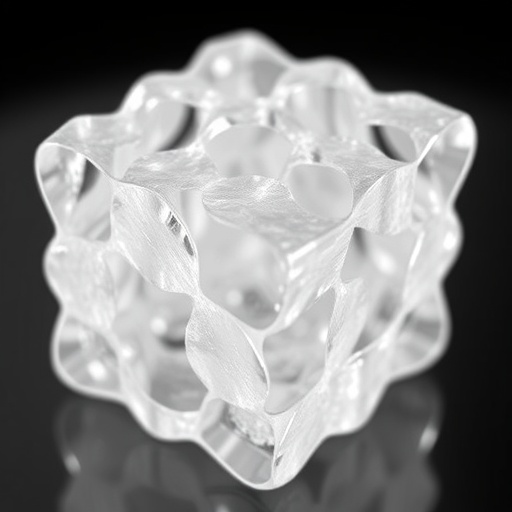In a groundbreaking advancement in the field of supramolecular chemistry and materials science, researchers from the Institute of Physical Chemistry of the Polish Academy of Sciences in Warsaw, in collaboration with Warsaw University of Technology and the University of Cambridge, have developed a novel class of robust, porous molecular crystals based on nanosized nickel(II) metal clusters. These extraordinary materials possess unique gas sorption properties that hold substantial promise for environmental protection applications, particularly in the efficient separation and selective adsorption of industrially relevant gases such as hydrogen, carbon dioxide, methane, and nitrogen. The innovative approach harnesses the reversible self-assembly of metal-organic clusters driven by noncovalent interactions, enabling dynamic transitions between distinct microporous frameworks under controlled conditions.
The synthesis centers around a decanuclear nickel(II) hydroxyquinolinato-carbonato cluster, formulated as [Ni₁₀(μ₆-CO₃)₄(L)₁₂], where L symbolizes the hydroxyquinolinato ligand. This intricate metal-organic cluster, through self-assembly processes influenced by crystallization parameters such as solvent choice and temperature, yields two polymorphic porous frameworks: the diamondoid WUT-1(Ni) and the pyrite-like WUT-2(Ni). These frameworks differ in their pore geometries and adsorption characteristics, illustrating a remarkable structural adaptability rarely observed in noncovalent microporous materials. This polymorphic interconversion can be selectively triggered by exposure to specific organic vapors or thermal stimuli, offering a controllable mechanism to reversibly modulate porosity and gas uptake behavior.
One of the defining features of these nickel-based porous molecular crystals is their exceptional thermal and chemical stability, maintaining structural integrity in aerobic as well as aqueous environments. This resilience addresses a pivotal challenge in the field of porous molecular materials, many of which struggle to preserve crystallinity and function under humid or oxidizing conditions. The WUT-1(Ni) framework exhibits notably high hydrogen adsorption capacities that surpass those of its previously reported isostructural zinc analog, WUT-1(Zn), positioning it among the highest-performing noncovalent porous materials for H₂ storage. Such advancements bear significant implications for hydrogen fuel technologies, where material stability and loading efficiency are crucial.
Conversely, the WUT-2(Ni) framework presents ultramicroporous voids with relatively smaller pore sizes engineered to foster selective binding interactions with guest gas molecules. This structural nuance translates to excellent selectivity ratios for CO₂ adsorption over other gases like methane (CH₄) and nitrogen (N₂), which are of utmost interest for carbon capture and natural gas purification technologies. The capacity to fine-tune pore environments and selectivity through a simple metal center substitution—from zinc to nickel—showcases the profound role the nature of metal ions plays in dictating the adsorption dynamics and robustness of molecular porous solids.
Mechanistically, the use of nickel(II) ions imparts enhanced chemical stability and promotes stronger host-guest interactions relative to zinc(II), as demonstrated by improved gas uptake and selectivity. The incorporation of hydroxyquinolinato ligands facilitates a delicate balance of rigidity and flexibility in the cluster framework, allowing the materials to respond dynamically to environmental stimuli without permanent loss of crystallinity. This adaptive behavior exemplifies a new paradigm in the design of smart porous materials where noncovalent forces guide self-assembly while preserving functional integrity under operational conditions.
The discovery addresses a longstanding bottleneck in supramolecular chemistry: achieving robust and functionally versatile porous frameworks constructed exclusively by weak noncovalent interactions without recourse to classical covalent frameworks like metal-organic frameworks (MOFs) or covalent organic frameworks (COFs). This breakthrough exemplifies how molecular design coupled with precise synthetic control can yield kinetically and thermodynamically stable microporous solids that rival traditional materials, while offering reversible structural rearrangements rarely accessible in rigid frameworks.
The polymorphic transformation between the WUT-1(Ni) and WUT-2(Ni) forms—achieved simply by altering the crystallization environment or applying external stimuli such as temperature or organic solvent vapor exposure—demonstrates the materials’ switchable porosity. This property expands their utility toward separation processes where feed gas composition and operating conditions fluctuate, requiring flexible sorbents that adapt in situ to maximize efficiency.
Importantly, this study paves the way toward the rational design of next-generation porous solids by elucidating the intricate influence of metal centers on the self-assembly pathways and final microporous topology. The ability to tailor gas sorption characteristics through targeted metal substitution and control over cluster crystallization may inspire further exploration of heterometallic clusters and functional ligand modifications to achieve bespoke adsorption profiles.
From an environmental standpoint, these nickel-based porous molecular crystals offer a promising platform for gas separation technologies aimed at reducing greenhouse gas emissions, enhancing hydrogen storage for renewable energy applications, and advancing purification processes in chemical industries. Their facile synthesis, chemical robustness, and tunable gas affinity position them as intriguing candidates for industrial adaptation once scaled beyond laboratory settings.
Looking ahead, the insights derived from this research encourage the pursuit of supramolecular assemblies that reconcile the demands for porosity, stability, and dynamic responsiveness in practical materials. Integrating these principles with advanced characterization and computational modeling will further unravel structure-property relationships, accelerating the deployment of molecular porous solids in real-world gas separation and storage systems.
In conclusion, the innovation reported by the Polish and British teams articulates a sophisticated marriage between inorganic cluster chemistry and supramolecular design, achieving a feat—the creation of robust, adaptable, and chemically stable microporous frameworks solely assembled by noncovalent forces. This work significantly enriches the landscape of porous materials science, imparting valuable paradigms for future exploration and technological exploitation.
Subject of Research: Development of robust supramolecular porous molecular crystals based on nickel(II) metal clusters for selective gas sorption and environmental applications.
Article Title: Efficient Preparation and Structural Adaptability of Nanosized Ni(II) Hydroxyquinolinato-Carbonato Clusters Yielding Polymorphic Microporous Frameworks with Exceptional Gas Sorption.
Web References:
– https://doi.org/10.1021/jacs.5c04096
Image Credits: Photo: Grzegorz Krzyzewski
Keywords
porous molecular crystals, nickel(II) clusters, gas sorption, supramolecular chemistry, microporous frameworks, polymorphism, hydrogen storage, carbon dioxide capture, noncovalent interactions, environmental protection, cluster self-assembly, material stability
Tags: durable porous crystalsdynamic structural adaptabilityefficient gas separation technologiesenvironmental protection applicationsflexible gas sorption materialsmetal-organic cluster self-assemblymicroporous framework designnickel(II) metal clustersnoncovalent interactions in materialspolymorphic material synthesisselective gas adsorption methodssupramolecular chemistry advancements





